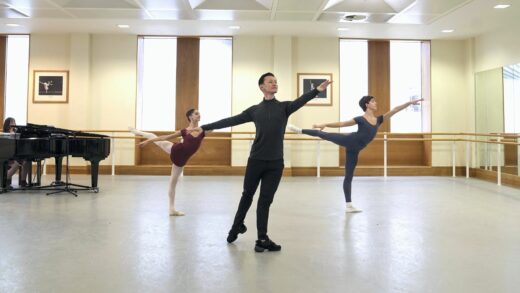Ballet class: relationship with the floor
A full class in which students will work on their relationship with the floor to improve skill in adage, turning and jumping.
£12.00
- 1 Class
- Suitable for 16+
A full ballet class to develop students’ awareness of the relationship with the floor. Particular attention will be paid to coming down from demi-pointe. This will help increase strength and control in adage as well as the endings of turns and softer, safer landings from jumps.
What you will learn
-
Improved awareness of shifting weight
-
Improved sensation of the articulation of the feet and a sense of resistance coming down from relevé
-
Improved dynamic in plié to cushion the landings from jumps and the end of turns
Your Tutors

Paul Lewis
Ballet Teacher
Paul started ballet at the age of 10, training with Leo Kersley. He then joined The Legat School and The Royal Ballet School before embarking on his professional career with Northern Ballet Theatre in 1984.
In his first professional year he danced Florestan pas de trois in Sleeping Beauty and Lysander in A Midsummer Night’s Dream by Robert De Warren. In 1985 he joined The Royal Ballet of Flanders as a junior soloist. There he danced The Teacher in Fleming Flindt’s The Lesson as well as roles by George Balanchine, Jiri Kylian, Auguste Bournonville, Violette Verdi and Valerie Panov. Paul returned to Northern Ballet Theatre in 1989 as a soloist. He created many roles for Christopher Gable including Hilarion in Giselle and Rothbart in Swan Lake.
Paul joined English National Ballet in 1992 and was quickly promoted to Soloist. He danced Tybalt in Rudolph Nureyev’s Romeo and Juliet and many other roles in the company repertoire. He also created the role of Rothbart for Derek Deane’s Swan Lake ‘in the round’ and although he left the company in 1999 to pursue a teaching career, Paul has returned many times as a Guest Character Artist and company teacher.
Paul became the 2nd year boys’ teacher at Central School of Ballet in 2005 where he stayed for five years. He joined English National Ballet School in September 2010 as 3rd Year boys’ Teacher and Artistic Co-ordinator.
Paul has taught in the USA, Japan, twice at the Yorkshire Ballet Summer School and as a guest teacher at Paris Opera Ballet School in October 2015. Paul returned to The Royal Ballet School as the 1st Year men’s teacher in November 2013.
Frequently Asked Questions
Who can participate?
These classes are recommended for students aged 16+ and reflect the training given to students aged 16-19 studying at The Royal Ballet School. The classes are not suitable for beginner students, students with limited experience or students under 15 years old.
For these classes, we recommend that:
- Students are regularly training in a recognised classical ballet syllabus at a vocational level of Advanced 2 or above, or studying at an equivalent level in full-time vocational training
- Students have an excellent and broad knowledge of ballet vocabulary and can follow the class using only verbal instruction if necessary
- Students will have strong and secure basic technique with an understanding of correct placement
- Barrework should be strong with clean execution and secure demi-pointe work
- Adage will have strong, secure placement and extensions will be at 90 degrees or above
- Pirouettes are secure and students will have the ability to execute multiple turns
- Allegro, including batterie, should be executed with good understanding of secure take-off and landings
- Students undertaking pointe work will be confident in advanced exercises.
What do I need to participate?
These classes are designed so that they can be executed in a smaller space than a ballet studio. We ask that students/parents ensure that:
- The student meets the technical standards required for the class
- Any apparatus used for a barre is stable and safe
- The floor is not slippery, uneven or hazardous
- The area used for dancing is cleared of any items which could hinder the student’s ability to fully extend their arms and legs. There should be enough space for reasonable movement. If a student cannot fully execute an exercise, they should either adapt appropriately or not participate
- The student is able to clearly hear the teacher’s verbal instruction, see the teacher’s practical delivery and hear the music
- The student is appropriately dressed to safely execute a dance class. Soft ballet shoes should be worn for ballet, not pointe shoes. Bare feet, socks or suitable shoes should be worn for contemporary and Pilates
- The student’s hair is suitably tied back
- The student is fit and well in order to take part.




